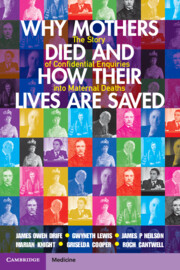 Why Mothers Died and How their Lives are Saved
Why Mothers Died and How their Lives are Saved Published online by Cambridge University Press: 05 April 2023
In the 1990s half a million women died each year from pregnancy-related causes. In 1995 the United Nations set the goal of a 75% reduction by 2015. A 43% fall was achieved. In 2020 the maternal mortality rate for low-income countries was 462/100,000 births. For every death, another 30 women suffer severe complications. Saving lives need not be expensive. As Prof. Mahmoud Fathalla said at the Safe Motherhood Movement launch in 1987, 'mothers are dying because societies have yet to make the decision that their lives are worth saving'. He had been inspired by the UK Enquiries. In 2004 WHO published a toolkit, Beyond the Numbers, mostly written by the director of the UK CEMD. It described how local mortality reviews, hospital-based or community-based, and near-miss reviews can be carried out without the government support which is needed for a national Enquiry. The principles of the CEMD apply to those reviews. Their aim is not to find scapegoats but to identify problems and suggest solutions. Confidentiality is vital if people are to be frank about individual and systemic failures. A safety culture requires support at individual, institutional and political levels.
To save this book to your Kindle, first ensure no-reply@cambridge.org is added to your Approved Personal Document E-mail List under your Personal Document Settings on the Manage Your Content and Devices page of your Amazon account. Then enter the ‘name’ part of your Kindle email address below. Find out more about saving to your Kindle.
Note you can select to save to either the @free.kindle.com or @kindle.com variations. ‘@free.kindle.com’ emails are free but can only be saved to your device when it is connected to wi-fi. ‘@kindle.com’ emails can be delivered even when you are not connected to wi-fi, but note that service fees apply.
Find out more about the Kindle Personal Document Service.
To save content items to your account, please confirm that you agree to abide by our usage policies. If this is the first time you use this feature, you will be asked to authorise Cambridge Core to connect with your account. Find out more about saving content to Dropbox.
To save content items to your account, please confirm that you agree to abide by our usage policies. If this is the first time you use this feature, you will be asked to authorise Cambridge Core to connect with your account. Find out more about saving content to Google Drive.